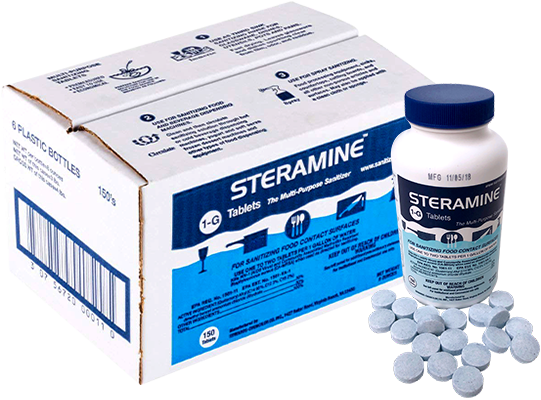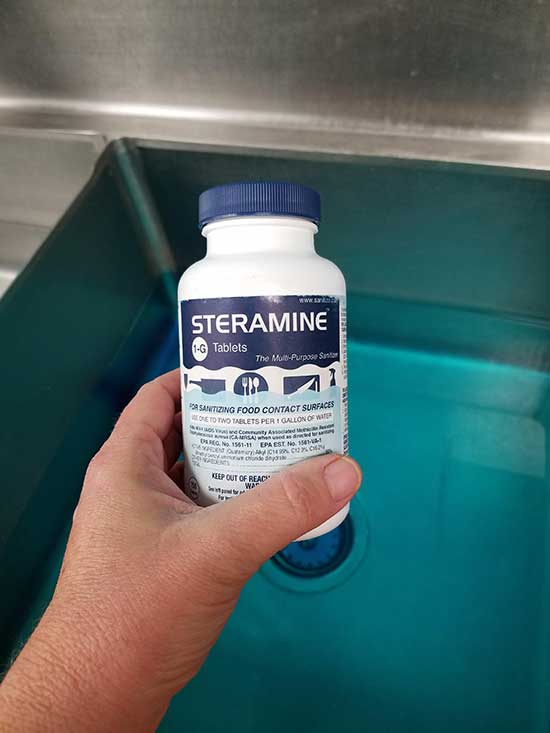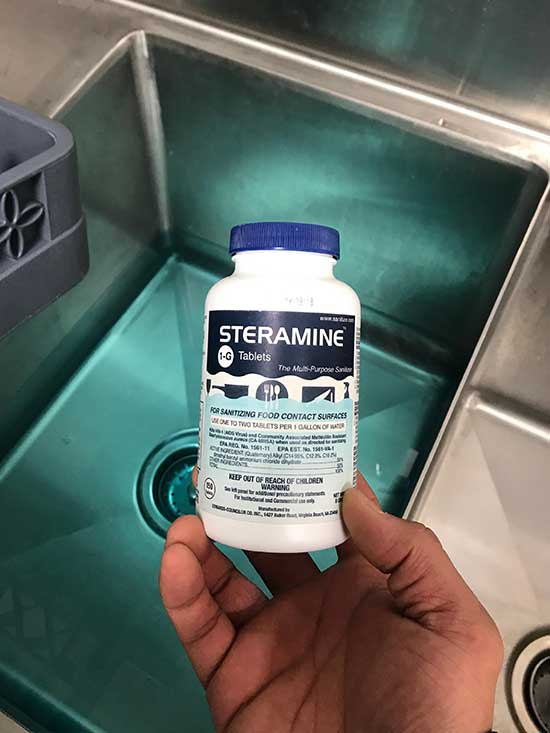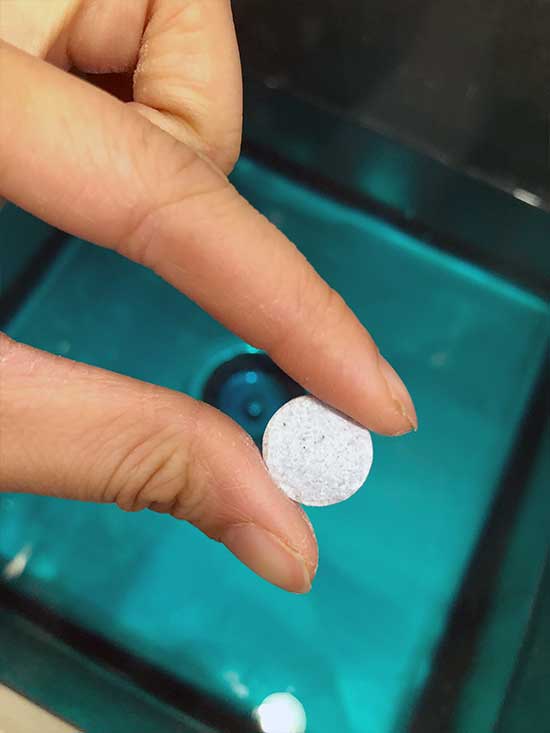- Free shipping throughout the USA!
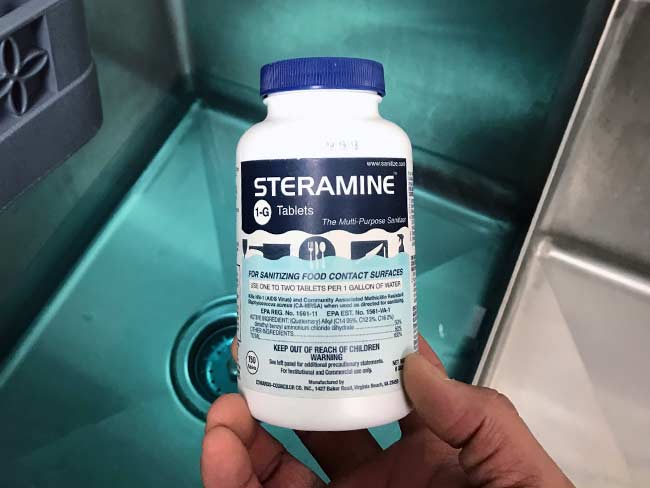
Steramine is a quaternary ammonium (QUAT) sanitizer approved by the EPA and USDA as a safe and effective sanitizer for use in restaurants, bars, daycare centers, gyms, assisted-living facilities, schools and more. It’s the first sanitizing product successfully tested, evaluated, accepted and registered by the EPA as an effective sanitizer to kill exposed HIV-1 (AIDS Virus) and other infectious bacteria.
Many kitchens use bleach as their sanitizing agent for third-sink compartments and general cleaning, but how does bleach weight up to Steramine? Is Steramine better than bleach? While it is a fast and cheap option, chlorine bleach has a many strikes against it. We outline key reasons why you should consider switching out caustic bleach sanitizing solutions with Steramine Sanitizer tablets:
1. Steramine is more stable and reliable than bleach
To understand the stability of chlorine bleach solutions, one needs to understand how bleach works. Bleach works by causing a chemical reaction when exposed to water molecules which forms hypochlorous acid. The concentration of hypochlorous acid created by the bleach decreases or increases the pH of the solution which determines how powerful, and how harmful, the sanitizing solution is.
Effective and safe sanitizing solutions have a recommended pH of 6.5 to 7.5. pH values less than 6 are more corrosive and damaging to equipment, and values lower than 5 begin to generate gas that is potentially harmful to humans. A solution with a pH higher than 8 will lose its effectiveness as a sanitizer. As bleach has a shelf life and deteriorates in strength with time in storage, monitoring the bleach solution to ensure effective sanitation is there for tedious!
Steramine tablets go years without decomposition and come pre-measured – under or over mixing is a struggle of the past. Dissolve 1 tablet in 1 gallon of water to produce a sanitizing solution of 200 parts per million of concentration to meet health department regulations, every single time! Test your Steramine solution throughout the day with QUAT test strips to know when it’s time to mix a fresh batch.
2. Steramine is much easier to store than bleach
Not only is it difficult to maintain an effective and safe bleach sanitizing mixture, but bleach is also difficult and inconvenient to store.
Steramine Sanitizer Tablets are an incredible space saver as it is very highly concentrated. Think dynamite in small packaging! One bottle of 150 Steramine tablets, small enough to fit in one hand, makes 150 gallons of cleaning solution. 5 bottles of Steramine can make 750 gallons of sanitizing solution, and only as and when needed. Imagine trying to store 750 gallons of bleach!
Bleach also has stringent storage guidelines as it has a short shelf life and expires. Quaternary ammonium sanitizers such as Steramine do not have stringent storage guidelines. Steramine also has no expiration date, which brings us to the next point:
3. Steramine has a longer shelf life than bleach
Chlorine bleach products have a shelf life of only 6 months. Bleach starts to deteriorate from the day it is made and bottled.As it starts the decomposition process, bleach starts to form sodium salts, reducing the effectiveness of the sanitizing action. Bleach in storage needs to be stored at the lowest possible temperatures, at the lowest concentration and for the shortest possible time. It’s therefor important to understand storage practices and use up bleach very quickly to avoid waste and ineffective sanitation.
Steramine Sanitizer Tablets, however, have no expiration date. A bottle of Steramine can stand for a decade or longer and still be effective! This is because Steramine only becomes active when you dissolve it in water.
4. Steramine has a more powerful sanitizing action
A freshly made Steramine sanitizing solution has more sanitizing strength than bleach because it activates when you mix it with water. As you learned from the previous point, bleach already starts to deteriorate and become less effective from the day it is made and bottled.
A Steramine solution is used as you mix it, so you have a freshly activated and powerful sanitizer for the day. It’s most effective right when you mix it, so it’s still important to prepare a fresh Steramine solution daily or more often if the solution becomes dirty or diluted from use. It’s so easy to do!
Steramine is tested and proven to kill bacteria and germs such as CA-MRSA, Escherichia coli (E-Coli), HIV-1 (Aids Virus), Listeria monocytogenes, Staphylococcus aureus etc.
5. Steramine is safer than bleach
Guidelines have been issues by the OSHA (The Occupational Safety and Health Administration) which require masks and gloves be used by anyone coming into contact with bleach solutions. This is due to the corrosive nature of chlorine bleach and because bleach forms hypochlorous acid when mixed with water. Hypochlorous acid is harmful for humans in very high concentrations.
Steramine is approved by and meets all public health and regulatory criteria for safety and effectiveness by the U.S Environmental Protection Agency, U.S Public Health Service, and the U.S Food and Drug Administration. No goggles and gloves are needed when using Steramine, it’s non-carcinogenic and it’s even safe for use in the home around children and pets. Unlike bleach, Steramine is non-toxic, non-corrosive and does not irritate the skin.
The Conclusion
It cannot be argued that bleach remains a viable, cheap and widely used disinfectant agent in the food service industry. However, when considering factors such as sanitation effectiveness, convenience, shelf life, concentration and employee safety, Steramine is the clear winner!
Ready to move to Steramine? Buy now with FREE USA SHIPPING
